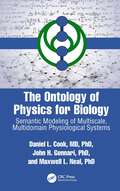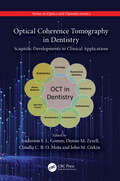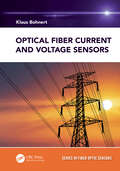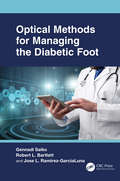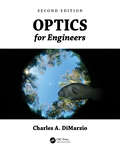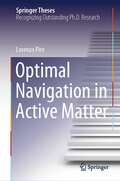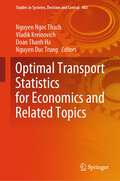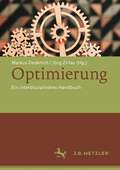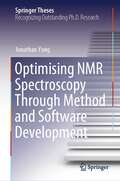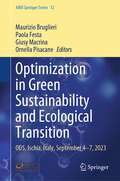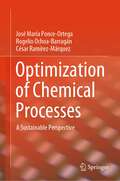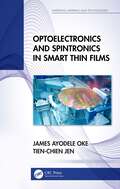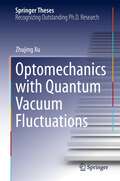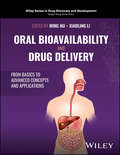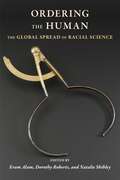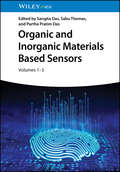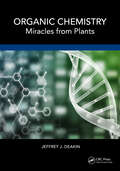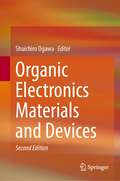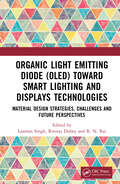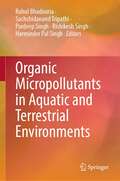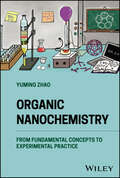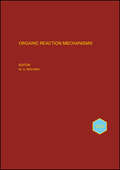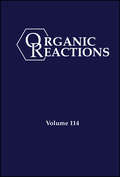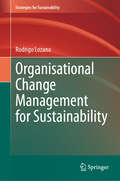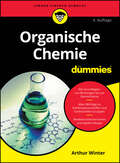- Table View
- List View
The Ontology of Physics for Biology: Semantic Modeling of Multiscale, Multidomain Physiological Systems
by Daniel L. Cook John H. Gennari Maxwell L. NealThis book introduces semantic representations of multiscale, multidomain physiological systems that link to qualitative reasoning and to quantitative analysis of biophysical processes in health and disease. Two major public health problems, diabetes and hypertension, serve as use-cases to illustrate the depth and rigor of such representations for logical inference and quantitative analysis. Central to this approach is the Ontology of Physics for Biology (OPB) that formally represents the foundations of classical physics and engineering system dynamics that are the basis for our understanding of biomedical entities, processes, and functional relationships. Furthermore, we introduce OPB-based software for annotating and abstracting available biosimulation models for reuse, recombination, and for archiving of physics-based biomedical knowledge. We have formalized and leveraged physics-based biological knowledge as a working view of physiology and biophysics from three distinct perspectives: (1) biologists and biomedical investigators, (2) biophysicists and bioengineers, and (3) biomedical ontologists and informaticists. We present a logical and intuitive semantics of classical physics as a tool for mediating and translating biophysical knowledge among biomedical domains. Daniel L. Cook, MD, PhD John H. Gennari, PhD Maxwell L. Neal, PhD
Optical Coherence Tomography in Dentistry: Scientific Developments to Clinical Applications (Series in Optics and Optoelectronics)
by Gomes, Anderson S. L.Optical Coherence Tomography (OCT), a method to "see inside of things" without destroying them, has been applied to subjects ranging from materials science to medicine. This book focuses on the biomedical application of OCT in dentistry, covering topics from dental materials to clinical practice. Since the introduction of the OCT method in ophthalmology in 1991, and then dentistry in 1998, developments in OCT methods, particularly in biomedical areas, have led to its dissemination worldwide. The chapters of this book cover the basics and recent global advances of OCT in dentistry, including an overview of the method and its use in cariology, restorative dentistry, dental materials, endodontics, pediatric dentistry, orthodontics, prosthodontics, soft oral tissues and nanodentistry. This book will be of interest to both newcomers in the field as well as those already working in OCT, either in research and/or the clinic. It will be of great use in courses on optical imaging applied to biomedical areas, particularly where it can provide real-life examples of the application of OCT.
Optical Fiber Current and Voltage Sensors (Series in Fiber Optic Sensors)
by Klaus BohnertOptical Fiber Current and Voltage Sensors is the first book to provide a complete, comprehensive and up to date treatment of the domain of fiber optic and polarimetric sensors, covering fundamental operating principles, characteristics, and construction. Written by one of the most recognised experts in polarimetric sensing, Optical Fiber Current and Voltage Sensors begins by covering the fundamentals of polarized light, as well as essential sensor components. The author then goes on to outline various sensor types and their applications, with a focus on sensors for electric phenomena. The chapters then lay out the demands that sensors need to meet, the technical obstacles and limitations which need to be considered. The book also covers comparisons to corresponding traditional instruments, as well as covering alternative non-conventional sensors. This book will be of interest to a broad audience of prospective readers ranging from graduate research students, to researchers in physics and engineering fields, to industry professionals active in the field who wish to learn about the technology and/or are interested in the development of new commercial solutions based on polarimetric-type fiber sensing as well as their use for high voltage current and voltage sensing.
Optical Methods for Managing the Diabetic Foot
by Gennadi Saiko Robert L. Bartlett Jose L. Ramirez-GarciaLunaThis book discusses optical technologies for Diabetic Foot management. It combines the current medical literature review with an overview of the technology and physics behind it. Thus, it is a single-source introduction to the topic. It can also be used as a reference source and practical guide for the use of technology. The particular focus is on low-cost technologies, including hyperspectral imaging, thermography, and endogenous bacterial fluorescence. Moving diagnostic modalities closer to the patient (e.g., primary care) allows the disease to be detected at an earlier stage, thus improving outcomes. However, while some optical technologies are available commercially, they have not received wide clinical adoption due to gaps in knowledge translation to mainstream medicine. This book aims to narrow this gap with practical illustrations. The book will be of interest to a broad range of healthcare professionals, clinical researchers, engineers, and decision-makers, who are dealing with complications of diabetes. Key Features: Reviews the current state of technologies. Provides a practical guide with practical considerations and illustrations. Supplies a 360-degree view of the combination of clinical information with a technology background and primers on physics and engineering.
Optics for Engineers
by Charles A. DiMarzioThis textbook provides an accessible introduction to the fundamentals of geometric and physical optics as they relate to practical problems encountered by engineers and researchers in designing and analyzing optical systems.In this updated edition, the author focuses on topics that are critical to understanding how the basic principles of optics affect design decisions. In addition to information on breadboarding experiments and prototypes, the new edition also expands its coverage of diffraction and includes numerous complete examples, and practical remindersProfessor Charles A. DiMarzio is an associate professor in the Department of Electrical and Computer Engineering, the Department of Mechanical and Industrial Engineering, and the Department of Bioengineering at Northeastern University in Boston, Massachusetts. He spent 14 years at Raytheon Company’s Electro-Optics Systems Laboratory in coherent laser radar for air safety and meteorology. Among other projects there, he worked on an airborne laser radar, flown on the Galileo-II, to monitor airflow related to severe storms, pollution, and wind energy, and another laser radar to characterize the wake vortices of landing aircraft. His current research in biomedical optics focuses on microscopy including coherent imaging, structured illumination, and multi-modal imaging. He is also a founding member of Gordon-CenSSIS – the Gordon Center for Subsurface Sensing and Imaging Systems.
Optimal Navigation in Active Matter (Springer Theses)
by Lorenzo PiroEfficient navigation in terms of travel time and energy dissipation is of crucial importance for biological micro-swimmers. The design of optimally navigating artificial swimmers also has potentially valuable applications such as targeted drug delivery, which has become an increasingly realistic perspective due to the recent progress in the experimental realization of controllable microswimmers able to perform nontrivial tasks. Despite recent theoretical progress, the field still faces open challenges, notably in describing navigation problems that take into account the complexities of the world of microswimmers.This book presents a selection of works on the problem of optimal microswimmer navigation that represent a significant advance in this direction. The material in this book provides important insights into how efficient navigation may be achieved in the presence of curved space geometry, confining forces and flows, as well as thermal fluctuations. Finally, the energetic cost of navigation is addressed via a new formulation of the problem that accounts for the swimmer body geometry.
Optimal Transport Statistics for Economics and Related Topics (Studies in Systems, Decision and Control #483)
by Nguyen Ngoc Thach Vladik Kreinovich Doan Thanh Ha Nguyen Duc TrungThis volume emphasizes techniques of optimal transport statistics, but it also describes and uses other econometric techniques, ranging from more traditional statistical techniques to more innovative ones such as quantiles (in particular, multidimensional quantiles), maximum entropy approach, and machine learning. Applications range from general analysis of GDP growth, stock market, and consumer prices to analysis of specific sectors of economics (construction, credit and banking, energy, health, labor, textile, tourism, international trade) to specific issues affecting economy such as bankruptcy, effect of Covid-19 pandemic, effect of pollution, effect of gender, cryptocurrencies, and the existence of shadow economy. Papers presented in this volume also cover data processing techniques, with economic and financial application being the unifying theme. This volume shows what has been achieved, but even more important are remaining open problems. We hope that this volume will: inspire practitioners to learn how to apply state-of-the-art techniques, especially techniques of optimal transport statistics, to economic and financial problems, and inspire researchers to further improve the existing techniques and to come up with new techniques for studying economic and financial phenomena.
Optimierung: Ein interdisziplinäres Handbuch
by Markus Dederich Jörg ZirfasDieses interdisziplinäre Handbuch rekonstruiert Optimierung als ein Phänomen, das konstitutiv in aktuelle Entwicklungen der Gegenwart eingeschrieben ist. Denn es erscheint kaum mehr möglich, nicht optimieren zu wollen oder zu können. Das gilt für die Arbeit an sich selbst, die Verbesserung des Anderen und die Perfektionierung der Welt. Optimierung verspricht messbare Steigerungen von Effektivität und Effizienz sowie eine Erweiterung der Reichweite von Einfluss und Macht. Sie wirft aber auch Fragen der Instrumentalisierung, der Verdinglichung und Entfremdung sowie Fragen nach Grenzen und Unverbesserlichkeiten auf. Ohne eine Auseinandersetzung mit der Idee der Optimierung lässt sich eine moderne Humanwissenschaft heute nicht mehr konzipieren.
Optimising NMR Spectroscopy Through Method and Software Development (Springer Theses)
by Jonathan YongThis book provides a comprehensive overview of Nuclear Magnetic Resonance (NMR) theory, its applications, and advanced techniques to improve the quality and speed of NMR data acquisition. In this book, the author expands his outstanding Ph.D. thesis and provides a valuable resource for researchers, professionals, and students in the field of NMR spectroscopy. The book covers quantum mechanics basics, and topics like density operators, pulse sequences, 1D pulse acquisition, INEPT (Insensitive nuclei enhancement by polarization transfer), product operators, and 2D NMR principles. It also explores innovative experiments like States HSQC (Heteronuclear Single Quantum Coherence) and echo-antiecho HSQC with gradients. In the subsequent chapters, the author discusses Pure Shift NMR, including PSYCHE (Pure Shift Yielded by Chirp Excitation) and its optimizations, such as waveform parameterization and time-reversal methods. The 'Discrete PSYCHE' approach and Ultrafast PSYCHE-iDOSY (Diffusion-ordered spectroscopy) are also highlighted. This book presents the POISE (Parameter Optimisation by Iterative Spectral Evaluation) software for real-time NMR experiment optimization, including pulse width calibration and Ernst angle optimization, and demonstrates applications across various NMR experiments. Lastly, the book examines accelerated 2D NMR data collection and the NOAH (NMR by Ordered Acquisition using 1H detection) supersequences, emphasizing automated pulse program creation using GENESIS (GENEration of Supersequences In Silico). Covered NMR experiments include 13C sensitivity-enhanced HSQC, 15N HMQC (Heteronuclear Multiple Quantum Coherence), dual HSQC, HSQC-TOCSY (Total Correlation Spectroscopy), HMBC (Heteronuclear Multiple Bond Correlation), and ADEQUATE (Adequate Sensitivity Double-Quantum Spectroscopy).
Optimization in Green Sustainability and Ecological Transition: ODS, Ischia, Italy, September 4–7, 2023 (AIRO Springer Series #12)
by Maurizio Bruglieri Paola Festa Giusy Macrina Ornella PisacaneThis book collects selected contributions of the “Optimization and Decision Science - ODS2023” international conference on the theme of optimization in green sustainability and ecological transition. ODS2023 was held in Ischia, 4–7 September 2023, and was organized by AIRO, the Italian Operations Research Society. The book offers new and original contributions on operations research, optimization, decision science, and prescriptive analytics from both a methodological and applied perspectives with a special focus on SDG related topics.It provides a state-of-the art on problem models and solving methods to address a widely class of real-world problems, arising in different application areas such as logistics, transportation, manufacturing, health, ICT and mobile networks, and emergency/disaster management. In addition, the scientific works collected in this book aim at providing significant contributions in the themes of sustainability, traffic and pollution reductions, and energy management.This book is aimed primarily at researchers and Ph.D. students in the Operations Research community. However, due to its interdisciplinary contents, this book is of high interest also for students and researchers from other disciplines, including artificial intelligence, computer sciences, finance, mathematics, and engineering as well as for practitioners facing complex decision-making problems in logistics, manufacturing production, and services.
Optimization of Chemical Processes: A Sustainable Perspective
by José María Ponce-Ortega Rogelio Ochoa-Barragán César Ramírez-MárquezThis textbook introduces readers to a comprehensive framework for the application of deterministic optimization strategies in the field of chemical processes, with a strong emphasis on sustainability.The book establishes a vital connection between fundamental deterministic optimization principles, optimization tools, and real-world application instances, all within the context of environmentally responsible practices. The approach put forth in this book is exceptionally versatile, allowing for the use of many optimization software and deterministic techniques.Contained in the book are many fundamental optimization concepts, encompassing linear programming, nonlinear programming, integer programming, and multi-objective optimization, all tailored to promote sustainable decision-making. Furthermore, the book provides practical examples illustrating the application of these techniques within sustainable chemical processes as tutorials.The textbook also explores the utilization of popular optimization software platforms such as GAMS, MATLAB, and Python, demonstrating how these tools can be leveraged for eco-friendly process optimization. Through this comprehensive framework, readers can not only acquire the skills needed to optimize a wide range of processes but also learn how to do so with sustainability at the forefront of their considerations. This approach streamlines the optimization process, eliminating unnecessary complications along the way and ensuring that environmental and ethical considerations are integral to the decision-making process.
Optoelectronics and Spintronics in Smart Thin Films (Emerging Materials and Technologies)
by James Ayodele Oke Tien-Chien JenSmart thin films, composed of functional materials deposited in thin layers, have opened new avenues for the development of flexible, lightweight, and high-performance devices. Optoelectronics and Spintronics in Smart Thin Films presents a comprehensive overview of this emerging area and details the current and near future integration of smart thin films in solar cells, and memory storage. Offers an overview of optoelectronics and spintronics. Discusses synthesis of smart nanomaterials. Describes deposition techniques and characterization of thin films. Considers the integration and application of opto-spintronics for technological advancement of solar cells and memory storage devices. Focused on advancing research on this evolving subject, this book is aimed at advanced students, researchers, and engineers in materials, chemical, mechanical, and electrical engineering, as well as applied physics.
Optomechanics with Quantum Vacuum Fluctuations (Springer Theses)
by Zhujing XuThis thesis presents the first realization of non-reciprocal energy transfer between two cantilevers by quantum vacuum fluctuations. According to quantum mechanics, vacuum is not empty but full of fluctuations due to zero-point energy. Such quantum vacuum fluctuations can lead to an attractive force between two neutral plates in vacuum – the so-called Casimir effect – which has attracted great attention as macroscopic evidence of quantum electromagnetic fluctuations, and can dominate the interaction between neutral surfaces at small separations. The first experimental demonstration of diode-like energy transport in vacuum reported in this thesis is a breakthrough in Casimir-based devices. It represents an efficient and robust way of regulating phonon transport along one preferable direction in vacuum. In addition, the three-body Casimir effects investigated in this thesis were used to realize a transistor-like three-terminal device with quantum vacuum fluctuations. These two breakthroughs pave the way for exploring and developing advanced Casimir-based devices with potential applications in quantum information science. This thesis also includes a study of the non-contact Casimir friction, which will enrich the understanding of quantum vacuum fluctuations.
Oral Bioavailability and Drug Delivery: From Basics to Advanced Concepts and Applications (Wiley Series in Drug Discovery and Development)
by Ming Hu Xiaoling LiORAL BIOAVAILABILITY AND DRUG DELIVERY Improve the performance and viability of newly-developed and approved drugs with this crucial guide Bioavailability is the parameter which measures the rate and extent to which a drug reaches a user’s circulatory system depending on the method of administration. For example, intravenous administration produces a bioavailability of 100%, since the drugs are injected directly into the circulatory system; in the case of oral administration, however, bioavailability can vary widely based on factors which, if not properly understood, can result in a failure in drug development, adverse effects, and other complications. The mechanics of oral bioavailability are therefore critical aspects of drug development. Oral Bioavailability and Drug Delivery provides a comprehensive coverage of this subject as well as its drug development applications. Beginning with basic terminology and fundamental concepts, it provides a thorough understanding of the challenges and barriers to oral bioavailability as well as the possibilities for improving this parameter. The resulting book is an indispensable tool for drug development research. Oral Bioavailability and Drug Delivery readers will also find: Discussion questions in many chapters to facilitate comprehension Detailed discussion of topics including dissolution, absorption, metabolism, and more Real-world examples of methods in actions throughout Oral Bioavailability and Drug Delivery is ideal for pharmaceutical and biotechnology scientists working in drug discovery and development; researchers in chemistry, biology, pharmacology, immunology, neuroscience, and other related fields; and graduate courses in drug development and delivery.
Ordering the Human: The Global Spread of Racial Science (Race, Inequality, and Health #15)
by Eram Alam, Dorothy Roberts, and Natalie ShibleyModern science and ideas of race have long been entangled, sharing notions of order, classification, and hierarchy. Ordering the Human presents cutting-edge interdisciplinary scholarship that examines the racialization of science in various global contexts, illuminating how racial logics have been deployed to classify, marginalize, and oppress.These wide-ranging essays—written by experts in genetics, forensics, public health, history, sociology, and anthropology—investigate the influence of racial concepts in scientific knowledge production across regions and eras. Chapters excavate the mechanisms by which racialized science serves projects of power and domination, and they explore different forms of resistance. Topics range from skull collecting by eighteenth-century German and Dutch scientists to the use of biology to reinforce notions of purity in present-day South Korea and Brazil. The authors investigate the colonial legacies of the pathologization of weight for the Maori people, the scientific presumption of coronary artery disease risk among South Asians, and the role of racial categories in COVID-19 statistics and responses, among many other cases. Tracing the pernicious consequences of the racialization of science, Ordering the Human shines a light on how the naturalization of racial categories continues to shape health and inequality today.
Organic and Inorganic Materials Based Sensors, 3 Volumes
by Sangita Das Sabu Thomas Partha Pratim DasOrganic and Inorganic Materials Based Sensors A three-volume comprehensive overview of the development and applications of various novel potent molecular sensor frameworks In Organic and Inorganic Materials Based Sensors (3 Volume Set), a team of distinguished researchers delivers an interdisciplinary presentation of the engineering of high-performance biopolymer-based bio-nanocomposites, as well as strategies for the use of various molecules in the detection of environmentally important guest analytes. This three-volume book explores the most relevant technological developments in nanomaterials sensors and offers a broad and comprehensive overview of cutting-edge research on advanced materials in the fast-moving sensors industry. The authors explain the science behind nanomaterials for environmental remediation as well as the components and ingredients of the relevant materials. Readers will also find: Thorough introductions to sensory devices, polymer-based nano-biomaterials, and opto-electrochemical devices Comprehensive explorations of metal–organic frameworks, organic sensors, and organic–inorganic composite semiconductor sensors Practical discussions of vapochromic and vapoluminescent sensors Fulsome treatments of sensor ecosystems for health self-monitoring, including discussions of diabetes management Perfect for materials scientists, mechanical engineers, and analytical chemists, Organic and Inorganic Materials Based Sensors will also benefit inorganic and organic chemists, robotics engineers, and professionals working in the sensor industry.
Organic Chemistry: Miracles from Plants
by Jeffrey John DeakinHuman benefit from the organic chemistry of plants is incalculable in terms of health, food, comfort and security. Indeed, the future well-being of humanity rests in significant measure upon a responsible relationship with the plant kingdom in order to re-establish balance in the Earth’s natural environmental systems.In a highly readable volume, Organic Chemistry: Miracles from Plants presents many fascinating points of entry to the organic chemistry of a wide range of crucially-important, naturally-occurring, chemical substances which are derived from plants.Features: Presents in a readable and accessible manner many fascinating points of entry to the organic chemistry of a wide range of crucially-important, naturally-occurring, chemical substances which are derived from plants. Key concepts in and knowledge of organic chemistry are reinforced. Highly-relevant and contemporary context stimulates learning in organic chemistry. Searching exercises and extension materials are provided at the end of every chapter each of which is amply illustrated. In a single source, this volume provides knowledge, challenge and valuable learning opportunity in chemistry, medicine, nutrition and the environmental sciences.
Organic Electronics Materials and Devices
by Shuichiro OgawaThis book is an introductory text for graduate students, researchers in industries, and those who are just beginning to work on organic electronics materials, devices and their applications. The book includes mainly fundamental principles and theories for understanding organic electronics materials and devices, but also provides information about state-of-the-art technologies, applications and future prospects. These topics encompass physics for organic transistors, structure control technologies of polymer semiconductors, nanomaterials electronics, organic solar cells, organic electroluminescence and dynamics for excitation, among others. In this second edition, the topics that have had particular progress in the field of organic electronics over the past seven years were added. For example, Thermally Activated Delayed Fluorescence (TADF) technology for organic LED, the development of perovskite materials, light-emitting materials using nanomaterials and the development of skin sensors and wearable/embedded devices. The recent scientific understanding of organic electronics is also introduced. This book will help readers to be able to contribute to society with the technologies and science of organic electronics materials in the future.
Organic Light Emitting Diode (OLED) Toward Smart Lighting and Displays Technologies: Material Design Strategies, Challenges and Future Perspectives
by Laxman Singh Rituraj Dubey R. N. RaiThe book Organic Light Emitting Diode (OLED) Toward Smart Lighting and Displays Technologies, edited by Laxman Singh, Rituraj Dubey, and Prof. R. N. Rai, strives to address the multiple aspects of OLEDs and their applications in developing smart lightings and displays. OLEDs have been used in almost all kinds of digital displays like those of mobile phones, laptops, tablets, phablets, TVs, etc., due to their outstanding features, including superior color quality, low cost, wide viewing angle, easy fabrication, mercury-free manufacture, tenability, stretchability, flexibility, etc. Investigations related to the synthesis of new organic materials and fabrication techniques have inspired us to write this book, which will fulfil the desire and thirst of OLEDs-based researchers. Features• Nanolithographic techniques used and the challenges involved.• Printing technology for fabrication.• Designing of hybrid perovskites.• Stretchable and flexible materials used.• Metal–dielectric composites and efficiency of organic semiconductor via molecular doping for OLEDs applications.• Organic small molecule materials and display technologies involved.• New generation of organic materials with respect to photophysical approach.• Mixed valence π-conjugated coordination polymers used.• Electroluminescent polymer used.• Blue fluorescent and phosphorescent organic materials used. In comparison to other books available related to similar topics, this book aims at those audiences who are looking for a single source for a comprehensive understanding of strategies and their challenges with respect to material fabrication of OLEDs. This book covers the pace and productivity at a uniform level in each chapter with respect to the audiences, from doctoral student to postdoctoral researchers or from postdoctoral researchers to multidisciplinary field researchers with a background in physics, chemistry, materials science, and engineering, who are already working with organic materials and their applications.
Organic Micropollutants in Aquatic and Terrestrial Environments
by Rahul Bhadouria Sachchidanand Tripathi Pardeep Singh Rishikesh Singh Harminder Pal SinghThis book offers a comprehensive overview of the origins, occurrences, and remediation strategies for organic micropollutants in the environment. Divided into five parts, the book starts with a perspective on the sources and prevalence of organic micropollutants in our world, including aquatic ecosystems and urban soils, followed by an examination of the effects of these contaminants on health, agriculture, and the environment. In the third and fourth parts of the book, readers will learn more about the analysis and detection of organic micropollutants, and treatment and remediation strategies, respectively. The book closes with an overview of policies and regulatory measures, and critiques the fate of organic micropollutants in the aquatic environment. In this book, particular attention is given to topics such as: the intricate relationship between micropollutants, the environment, and human healthsustainable management, treatment methodsand remediation for micropollutants in wastewater, urban water systems, freshwaters, urban soils, and agricultureecotoxicity analysis and innovative bioremediation approachesReaders will also find a valuable discussion of the current contamination status of aquatic ecosystems by pharmaceutical and personal care micropollutants, the latest methodologies for analysing organic micropollutants, and a case study on the biodegradation pathways of hexachlorocyclohexane (HCH). Given its breadth, this book is a useful resource for scientists, researchers, policymakers, and anyone concerned about the ecological and human health impacts of organic micropollutants.
Organic Nanochemistry: From Fundamental Concepts to Experimental Practice
by Yuming ZhaoORGANIC NANOCHEMISTRY How-to guide for entry-level practitioners to quickly learn the cutting-edge research concepts and methodologies of modern organic nanochemistry Organic Nanochemistry describes the fundamentals of organic nanochemistry research, encompassing modern synthetic reactions, supramolecular strategies, nanostructure and property characterization techniques, and state-of-the-art data analysis and processing methods, along with synthetic chemistry as applied to organic nanomaterials and molecular devices. Accompanying each of these principles are case studies (from basic design to detailed experimental implementation) to help the reader fully comprehend the concepts and methods involved. Various theories suitable for nanoscale simulations, including quantum mechanics, semi-empirical quantum mechanics, and molecular dynamics theories, are discussed at an introductory level. Computational examples are provided, allowing interested readers to grasp essential modelling techniques for better understanding of organic nanochemistry. The content is paired with online supplementary material that includes instructional materials and guides to using common scientific software for computational modelling and simulations. Written by a highly qualified professor, Organic Nanochemistry includes discussion on: Key concepts and theories of organic chemistry, which are essential to understand the fundamental properties of organic molecular and supramolecular systems Useful synthetic methodologies for the synthesis and functionalization of organic nanomaterials, and the chemistry and application of exotic carbon nanomaterials Supramolecular aspects in organic nanochemistry, especially the well-developed disciplines of host-guest chemistry and organic self-assembly chemistry Construction and testing of molecular devices and molecular machines and state-of-the-art computational modelling methods for properties of nanoscale organic systems Guiding the reader on a journey from familiar chemical concepts and principles to cutting-edge research of nano-science and technology, Organic Nanochemistry serves as an excellent textbook learning resource for advanced and graduate students, as well as a self-study guide or how-to reference for practicing chemists.
Organic Reaction Mechanisms 2020 (Organic Reaction Mechanisms)
by M. G. MoloneyOrganic Reaction Mechanisms 2020, the 56th annual volume in this highly successful and unique series, surveys research on organic reaction mechanisms described in the available literature dated 2020. The following classes of organic reaction mechanisms are comprehensively reviewed: Reaction of Aldehydes and Ketones and their Derivatives Reactions of Carboxylic, Phosphoric, and Sulfonic Acids and their Derivatives Oxidation and Reduction Nucleophilic Aromatic Substitution Electrophilic Aromatic Substitution Carbocations Nucleophilic Aliphatic Substitution Carbanions and Electrophilic Aliphatic Substitution Elimination Reactions Polar Addition Reactions Cycloaddition Reactions Molecular Rearrangements Transition Metal Coupling Radicals An experienced team of authors compile these reviews every year, so that the reader can rely on a continuing quality of selection and presentation.
Organic Reactions, Volume 114 (Organic Reactions)
by P. Andrew EvansA carefully curated review of the scientific literature, Volume 114 of Organic Reactions presents critical discussions of widely used organic reactions or particular steps of a reaction. The material is treated from a preparative viewpoint, with emphasis on limitations, interfering influences, effects of structure and the selection of experimental techniques. The work includes tables that contain all possible examples of the reaction under consideration. Detailed procedures illustrate the significant modifications of each method. Launched in 1942, the Organic Reactions series today is a leading secondary- and tertiary-level source for organic chemists across the world.
Organisational Change Management for Sustainability (Strategies for Sustainability)
by Rodrigo LozanoThis book is aimed at providing clarity through a systemic and systematic approach to organisational change management for sustainability. Chapter 2 of the provides an overview of sustainable development and sustainability discourses, focussing on the economic, environmental, social, and time dimensions, as well as their interactions. Chapter 3 explains what organisations are, the types of organisations (civil society, corporations, education, public sector, and hybrid), the levels and system elements (individuals, groups, organisation, and system), attitudes (informational, emotional, and behavioural), the stakeholders that affect and are affected by the organisation, and the interactions between organisations (from competition to collaboration). Chapter 4 focuses on how organisations have been addressing sustainability, divided into 1) efforts to contribute to sustainability (i.e. focussing outside the organisation), and 2) engagement efforts (i.e. those focussing inside the organisation, e.g. through the use of tools, initiatives, and approaches for sustainability, and collaboration). Chapter 5 discusses change, types of change (internal vs. external, proactive vs. reactive, etc.), change strategies, change frameworks, and change for sustainability in organisations. Chapter 6 focusses on three key mechanisms for sustainability: Leadership, Governance, and Assessment and reporting (with examples from Higher Education Institutions, corporations, and public sector organisations). Chapter 7 discusses on the different drivers (internal, connecting, and external) that foster sustainability in organisations. Examples from empirical research are presented. Chapter 8 delves into resistance to change, particularly on the barriers that slow down or stop sustainability in organisations, as well as the strategies to overcome the barriers to change. Examples from empirical research are presented. The seventh chapter focuses on the different strategies that help reduce or eliminate resistance to sustainability in organisations. Examples from empirical research are presented. Chapter 9 focusses on where sustainability efforts have started (incorporation) and how have they been adopted throughout the organisation (institutionalisation). Examples from empirical research are presented. Chapter 10 presents the effects of external stimuli, such as COVID-19 on organisational change management for sustainability.
Organische Chemie für Dummies (Für Dummies)
by Arthur WinterHier dreht sich alles um Kohlenstoff Wie die Zusammenhänge und Konzepte der organischen Chemie funktionieren, lernen Sie in diesem Buch. Arthur Winter erklärt Ihnen, was Sie über Kohlenstoffverbindungen, funktionelle Gruppen und Reaktionsmechanismen wissen sollten. So erfahren Sie, welche Reaktionen möglich und welche unmöglich sind. Außerdem vermittelt er leicht verständlich auch komplexe Themen wie die Stereochemie und die Spektroskopie. Zu jedem Kapitel gibt es Übungsaufgaben und ausführlichen Lösungen. So unterstützt Sie das Buch nicht nur theoretisch, sondern auch praktisch bei Ihrem Einstieg in die Organische Chemie. Sie erfahren Wie Sie organische Strukturen korrekt zeichnen Wie Sie Reaktionsmechanismen erarbeiten Was Sie über Säuren, Basen und den pKs-Wert wissen sollten Welche Fachbegriffe Sie kennen müssen
